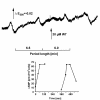A link of Ca2+ to cAMP oscillations in Dictyostelium: the calmodulin antagonist W-7 potentiates cAMP relay and transiently inhibits the acidic Ca2+-store
- PMID: 15147588
- PMCID: PMC419698
- DOI: 10.1186/1471-213X-4-7
A link of Ca2+ to cAMP oscillations in Dictyostelium: the calmodulin antagonist W-7 potentiates cAMP relay and transiently inhibits the acidic Ca2+-store
Abstract
Background: During early differentiation of Dictyostelium the attractant cAMP is released periodically to induce aggregation of the cells. Here we pursue the question whether pulsatile cAMP signaling is coupled to a basic Ca2+-oscillation.
Results: We found that the calmodulin antagonist W-7 transiently enhanced cAMP spikes. We show that W-7 acts on an acidic Ca2+-store: it abolished ATP-dependent vesicular acidification, inhibited V-type H+ATPase activity more potently than the weaker antagonist W-5 and caused vesicular Ca2+-leakage. Concanamycin A, an inhibitor of the V-type H+-pump, blocked the Ca2+-leakage elicited by W-7 as well as cAMP-oscillations in the presence of W-7. Concanamycin A caused an increase of the cytosolic Ca2+-concentration whereas W-7 did not. In case of the latter, Ca2+ was secreted by the cells. In accord with our hypothesis that the link from Ca2+ to cAMP synthesis is mediated by a Ca2+-dependent phospholipase C we found that W-7 was not active in the phospholipase C knockout mutant.
Conclusion: We conclude that the potentiation of cAMP relay by W-7 is due to a transient inhibition of the acidic Ca2+-store. The inhibition of the proton pump by W-7 causes a leakage of Ca2+ that indirectly stimulates adenylyl cyclase activity via phospholipase C.
Figures













Similar articles
-
Acidic Ca2+ stores, excitability, and cell patterning in Dictyostelium discoideum.Eukaryot Cell. 2009 May;8(5):696-702. doi: 10.1128/EC.00360-08. Epub 2009 Feb 27. Eukaryot Cell. 2009. PMID: 19252125 Free PMC article. Review. No abstract available.
-
cAMP controls cytosolic Ca2+ levels in Dictyostelium discoideum.BMC Cell Biol. 2005 Mar 7;6(1):12. doi: 10.1186/1471-2121-6-12. BMC Cell Biol. 2005. PMID: 15752425 Free PMC article.
-
EGF-like peptide-enhanced cell motility in Dictyostelium functions independently of the cAMP-mediated pathway and requires active Ca2+/calmodulin signaling.Cell Signal. 2011 Apr;23(4):731-8. doi: 10.1016/j.cellsig.2010.12.007. Epub 2010 Dec 31. Cell Signal. 2011. PMID: 21195758
-
Mechanism of cAMP-induced H(+)-efflux of Dictyostelium cells: a role for fatty acids.J Biosci. 2000 Sep;25(3):243-52. doi: 10.1007/BF02703931. J Biosci. 2000. PMID: 11022225
-
On the role of calcium during chemotactic signalling and differentiation of the cellular slime mould Dictyostelium discoideum.Int J Dev Biol. 1996 Feb;40(1):135-9. Int J Dev Biol. 1996. PMID: 8735922 Review.
Cited by
-
The contractile vacuole in Ca2+-regulation in Dictyostelium: its essential function for cAMP-induced Ca2+-influx.BMC Dev Biol. 2006 Jun 20;6:31. doi: 10.1186/1471-213X-6-31. BMC Dev Biol. 2006. PMID: 16787542 Free PMC article.
-
Ion Signaling in Cell Motility and Development in Dictyostelium discoideum.Biomolecules. 2024 Jul 10;14(7):830. doi: 10.3390/biom14070830. Biomolecules. 2024. PMID: 39062545 Free PMC article. Review.
-
Release of Ca2+ from the endoplasmic reticulum contributes to Ca2+ signaling in Dictyostelium discoideum.Eukaryot Cell. 2005 Sep;4(9):1513-25. doi: 10.1128/EC.4.9.1513-1525.2005. Eukaryot Cell. 2005. PMID: 16151245 Free PMC article.
-
Acidic Ca2+ stores, excitability, and cell patterning in Dictyostelium discoideum.Eukaryot Cell. 2009 May;8(5):696-702. doi: 10.1128/EC.00360-08. Epub 2009 Feb 27. Eukaryot Cell. 2009. PMID: 19252125 Free PMC article. Review. No abstract available.
-
cAMP controls cytosolic Ca2+ levels in Dictyostelium discoideum.BMC Cell Biol. 2005 Mar 7;6(1):12. doi: 10.1186/1471-2121-6-12. BMC Cell Biol. 2005. PMID: 15752425 Free PMC article.
References
-
- Kessin RH. Dictyostelium. Cambridge University Press; 2001.
-
- Söderbom F, Anjard C, Iranfar N, Fuller D, Loomis WF. An adenylyl cyclase that functions during late development of Dictyostelium. Development. 1999;126:5463–5471. - PubMed
Publication types
MeSH terms
Substances
LinkOut - more resources
Full Text Sources
Miscellaneous

